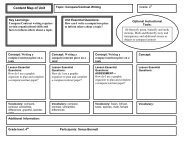Center Elementary School Title I Schoolwide/School Improvement ...
Center Elementary School Title I Schoolwide/School Improvement ...
Center Elementary School Title I Schoolwide/School Improvement ...
You also want an ePaper? Increase the reach of your titles
YUMPU automatically turns print PDFs into web optimized ePapers that Google loves.
<strong>Center</strong> <strong>Elementary</strong> <strong>School</strong><strong>Title</strong> I<strong>School</strong>wide/<strong>School</strong> <strong>Improvement</strong> Plan2011-2012SIP Components*1. A comprehensive needs assessment of the entire school that addresses all academic areasand other factors that may affect achievement.Response:Data is collected, disaggregated, and reported on a consistent basis. During the summer, the<strong>School</strong> <strong>Improvement</strong> Plan (SIP) Team, which includes administrators, counselors, grade levelrepresentatives, instructional coach, Special Education coordinator, parents, and students,begins looking at year end data (Spring CRCT and State Assessment results, benchmark data,RTI data, Report Card data and school-wide attendance) in preparation for the upcoming year.The GLISI model is used to analyze the multiple pieces of data. The SIP Team is divided intogroups to brainstorm and identify common trends. SMART goals are developed at this timeknowing that they may change when the official AYP report is released at the end of July. Atthe beginning of the school year the SIP Team meets to incorporate the Spring CRCT/StateAssessment results into the analysis. The group brainstorms again to see if strategies need to beadjusted. The results are shared with the faculty and parents and targets are identified forimprovement. Parents and community stakeholders receive data information during the systemwide Parent Involvement Meeting and <strong>Center</strong> <strong>Elementary</strong> <strong>School</strong>’s annual <strong>Title</strong> I meeting andInstructional Fair in September. During this meeting in September, data results, as well asParental Involvement Policies and <strong>School</strong> <strong>Improvement</strong> Plan are shared with parents andcommunity stakeholders. Data results are located in the Comprehensive Needs Assessment(Balanced Scorecard) and <strong>School</strong> <strong>Improvement</strong> Plan. This data is displayed in our schoolbrochure, lobby kiosk, parent involvement lobby notebook, school data bulletin board andschool website.*** Teachers continue to analyze data, formative and summative, every 9weeks. During two Extended Data Days, teachers gather, examine and develop action plans.A comprehensive needs assessment of the Migrant Education program at <strong>Center</strong> <strong>Elementary</strong> isconducted in the spring of each academic year. At this time, <strong>Center</strong> does not have a largemigrant population. Migrant students are afforded a variety of services through the MigrantEducation Program. For example, students are eligible to participate in summer programs,tutoring and education workshops activities. Students and their families are linked withcommunity health care providers and offered school accident insurance. Parents of migrantstudents are invited to participate in parental involvement opportunities and the Migrant ParentAdvisory Council.The State Longitudinal Data System (SLDS) is used to track how all students are performingon state mandated assessments as well as their attendance trends. Subgroup data is availableusing SLDS. Classroom teachers use the SLDS to see which areas (i.e. academic andDr. John D. Barge, State <strong>School</strong> SuperintendentApril 2011 ● Page 4 of 25















